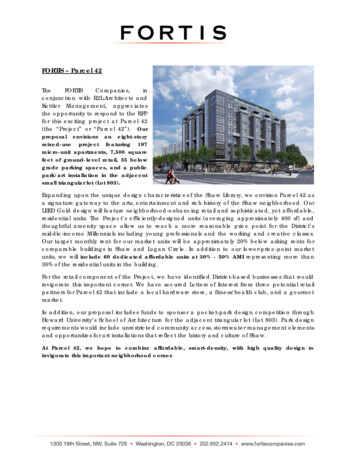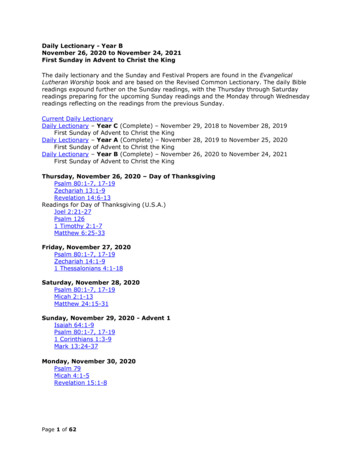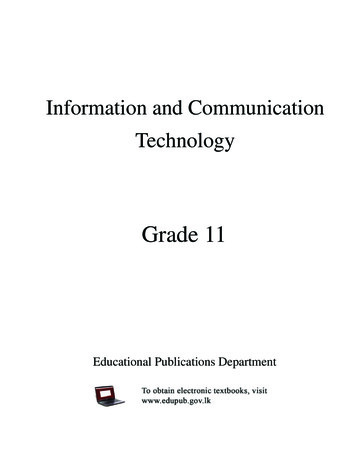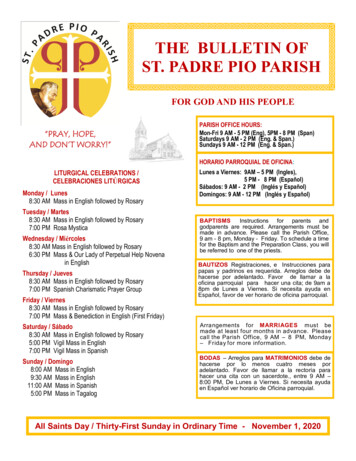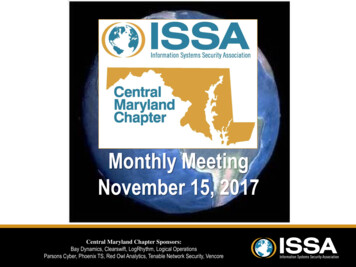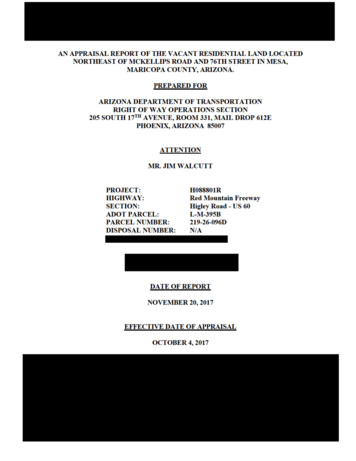
Transcription
November 20, 2017TO:Arizona Department of Transportation205 South 17th Avenue, Room 331 Mail Drop 612EPhoenix, Arizona 85007RE:PROJECT:HIGHWAY:SECTION:ADOT PARCEL:PARCEL NUMBER:ATTN:Mr. Jim WalcuttR/W Project Management SectionRE:An appraisal report of the 5 acres of vacant residential land located northeast of thenortheast corner of 76th Street and McKellips Road in unincorporated MaricopaCounty, Arizona.H088801RRed Mountain FreewayHigley Road - US 60L-M-395B219-26-096DDear Mr. Walcutt:As requested, I have appraised the aforementioned property, as of October 4, 2017, for the purposeof determining the market value.Due to the fact that the subject is vacant land with no lease encumbrances, the final opinion of valueis based upon the fee simple estate.The intended users of this appraisal report are the Arizona Department of Transportation (ADOT)and the Federal Highway Administration (FHWA) to utilize value estimates to assist in decisionsregarding the sale or disposal of the property. The Arizona Department of Transportation (ADOT)is our client and one of the intended users along with the Federal Highway Administration(FHWA). This appraisal is not intended for any other use by any other users.The appraisal and report were both prepared in conformity with the appraisal requirements of theArizona Department of Transportation, Uniform Standards of Professional Appraisal Practice, 20162017 (USPAP), and Uniform Relocation Assistance and Real Property Acquisition Policies Act of1970, as Amended (URA), as described in part 49 CFR 24.2(a)(3).This report was prepared under the Appraisal Report option of Standards Rule 2-2(a) of the 20162017 edition of USPAP. As USPAP gives appraiser the flexibility to vary the level of informationin an appraisal report depending on the intended use and intended users of the appraisal, I adhereinternal standards for an Appraisal Report- Standard Format.to
FACTS AND CONCLUSIONSTYPE OF PROPERTYVacant Residential LandLOCATIONThe subject is located northeast of McKellips Roadand 76th Street in unincorporated Maricopa County,Arizona. It is noted that the subject site is under thejurisdiction of Maricopa County (county island)however it is located within the city limits of Mesa.REPORT PURPOSEThe purpose of this report is to provide an estimate ofthe market value of the subject property as of the dateof inspection, or October 4, 2017.INTENDED USE/USER OF REPORT:The intended users of this appraisal report are theArizona Department of Transportation (ADOT)and the Federal Highway Administration (FHWA).The intended use is to assist in decisions regardingthe sale or disposal of the property.TAX PARCEL NUMBER:219-26-096DADOT PARCEL:L-M-395BSITE AREA:Based on information obtained from the MaricopaCounty Assessor, the subject site is 5.00 acres orapproximately 217,800 square feet in size.ZONINGR1-35, Low density single family residential byMaricopa County.It is noted that the subject site is under the jurisdictionof Maricopa County (county island) however islocated within the city limits of Mesa.According to the City of Mesa General Plan, thesubject is located within an area designated for lowdensity single family residential development (1-2du/acre).FLOOD ZONEThe location is within an area denoted as being in an"X" Flood Hazard Area, as found on FederalEmergency Management Agency Flood InsuranceRate Map number 04013C2285L dated October 16,2013.4
IMPROVEMENTSNoneHIGHEST & BEST USELow Density Residential developmentDATE OF APPRAISALOctober 4, 2017MARKET VALUE 400,0005
TABLE OF CONTENTSSCOPE OF WORK. 7REGIONAL AND CITY DATA . 15NEIGHBORHOOD DATA ANALYSIS . 31SUBJECT PHOTOGRAPHS . 41SITE DATA ANALYSIS . 48FLOOD ZONE MAP . 51HIGHEST AND BEST USE . 53VALUATION PROCESS. 58SALES COMPARISON APPROACH . 60RECONCILIATION . 77CERTIFICATION . 79ADDENDA. 84ADDENDAEngagement Letter .EXHIBIT 1Title Report .EXHIBIT 2Environmental Clearance Letter .EXHIBIT 3ADOT LOOP 202 Right of Way Plans.EXHIBIT 4Zoning Designation .EXHIBIT 5USPAP Reporting Options .EXHIBIT 6Contingent and Limiting Conditions .EXHIBIT 76
SCOPE OF WORKThe practice of appraisal can be considered to be less of a science dictated by strict rules and moreof an art, in which rules guide the appraiser towards a trustworthy, responsible and crediblevaluation. The Uniform Standards of Professional Appraisal Practice (USPAP) providesguidelines for this process to be undertaken through the Scope of Work Rule, to which all appraisalprofessionals must adhere.The appraisal and report were prepared in conformity with the appraisal requirements of the ArizonaDepartment of Transportation, Uniform Standards of Professional Appraisal Practice, 2016-2017(USPAP), and Uniform Relocation Assistance and Real Property Acquisition Policies Act of 1970,as Amended (URA), as described in part 49 CFR 24.2(a)(3).The USPAP 2016-2017 SCOPE OF WORK RULE states:For each appraisal and appraisal review assignment, an appraiser must:1. identify the problem to be solved;2. determine and perform the scope of work necessary to develop credible assignmentresults; and3. disclose the scope of work in the report.An appraiser must properly identify the problem to be solved in order to determine the appropriatescope of work. The appraiser must be prepared to demonstrate that the scope of work is sufficientto produce credible assignment results. (The Appraisal Foundation, USPAP 2016-2017 edition, Pg. U-13)Comment: Scope of work includes, but is not limited to: the extent to which the property is identified;the extent to which tangible property is inspected; the type and extent of data researched; and the type and extent of analyses applied to arrive at opinions or conclusions. Appraiser has broad flexibility and significant responsibility in determining the appropriate scopeof work for an appraisal, appraisal review, and appraisal consulting assignment.Credible assignment results require support by relevant evidence and logic. The credibility ofassignment results is always measured in the context of the intended use.For this individual assignment, the appraiser shall address the three aspects of the Scope of WorkRule; Problem Identification, Scope of Work Acceptability and Disclosure Obligations.7
SCOPE OF WORK ACCEPTABILITY:The scope of work must include the research and analyses that are necessary to develop credibleassignment results.An appraiser must not allow assignment conditions to limit the scope of work to such adegree that the assignment results are not credible in the context of the intended use.An appraiser must not allow the intended use of an assignment or a client’s objectives tocause the assignment results to be biased”. (The Appraisal Foundation, USPAP 2016-2017 edition.U-14)The client has requested that the appraiser estimate the market value of the subject property. Inorder to credibly perform this task, the appraiser has followed these general guidelines:-determination of problem and applicable Hypothetical Conditions or ExtraordinaryAssumptionsresearch on the subject property, including but not limited to: ownership history,applicable liens and easements, physical characteristics (i.e. size, topography), relevantsubject data (i.e. leases and financial statements for income producing properties)selection of, research on and collection of market data for the subject neighborhoodsite inspectionanalysis and synthesis of Highest and Best Use of the subject propertyselection of valuation methodology, subsequent research as is applicable, includingmarket participant and market expert research (i.e. Sales Comparison Approach, CostApproach, Income Approach, sales or rent comparable properties)analysis and conclusion of valuation methodology(ies)reconciliation of valuation methodology resultsconclusion of probable estimated market valueDISCLOSURE OBLIGATIONS:The report must contain sufficient information to allow intended users to understand thescope of work performed. (The Appraisal Foundation, USPAP 2016-2017 edition. U-14)AREA ANALYSIS DATA SOURCES:As part of this appraisal assignment, the appraiser made a number of independent investigationsand analyses. Data retained in office files, which are updated regularly, were also relied upon.Affidavits of Property Value were checked to verify information. Maps, aerials and zoningobtained from the affiliated municipalities were checked and also information provided by theclient.10
The Arizona State and Phoenix Metro area data was taken from many sources including, withoutlimitation, Arizona State University, Arizona State Department of Economic Security and the U.S.Census Bureau.All market data was confirmed from one or more of the following sources as indicated on theindividual sales: Maricopa County Assessor's Office (www.maricopacountyaz.gov), Affidavit ofProperty Value, Real Quest (www.realquest.com), CoStar Realty Information (www.costar.com),FLEXMLS Data Systems (www.flexmls.com), owners or their representatives, and/or Real EstateBrokers and/or Agents.NEIGHBORHOOD AND ANALYSIS:The neighborhood was researched and the contents of this report express my opinion of what wasfound and observed.SITE DESCRIPTION AND ANALYSIS:The site description and analysis was based on my personal physical inspection, informationobtained from the client and from information obtained from the Maricopa County and City ofMesa Engineering, Planning and Zoning Departments.LEGAL DESCRIPTION:The subject property is legally defined within the Title Report in the addenda of this report.OWNERSHIP:The owner of record as provided by Maricopa County is:ARIZONA DEPARTMENT OF TRANSPORTATION205 S 17TH AVE STE 612EPHOENIX, AZ 85007-3212OWNER CONTACT:Representatives of the Arizona Department of Transportation Mr. Jim Walcutt and Mr. TimMahoney, were present during the appraisers inspection on October 4, 2017.HISTORY:The subject property has been under the current ownership for over 5 years and there have been noprior transactions. It was reported by Mr. Walcutt that the property was marketed for sale previously,however, the property was thought to of had no legal access during the marketing period and therewere no bids to purchase. Since this attempt to sell the property it has been discovered that there isindeed access via an easement to the north.The appraiser is unaware of any other transactions over the previous five years.11
SCOPE OF VALUATION METHODOLOGY:The valuation process is an orderly program in which data used to estimate value of the subjectproperty is acquired, classified, analyzed, and presented. The first step in the process is to define theappraisal problem, i.e., identify the real estate, the effective date of the value estimate, the propertyrights being appraised, and the type of value sought. Once this has been accomplished, the appraisercollects and analyzes the factors that affect the fair market value of the subject property. These factorsare addressed in the area and neighborhood analysis, the site analysis, and the highest and best useanalysis. They are then applied to the subject property in the discussion of the three approaches tovalue.The Sales Comparison, Cost, and Income Capitalization Approaches are widely accepted methods ofestimating property value. Each approach is described briefly here and discussed in detail in theanalysis of each.To apply the Cost Approach, the depreciated replacement cost of the improvements is added to thevalue of the land as though vacant, derived through sales comparison, to arrive at a value estimate forthe subject property. This approach is most reliable when the improvements are new or nearly newand represent the highest and best use of the site. The subject is vacant land with no improvements,thus the Cost Approach will not be utilized.The Sales Comparison Approach is an approach through which an appraiser derives a value indicationby comparing the property being appraised to similar properties that have been sold recently, applyingappropriate units of comparison and making adjustments, based on the elements of comparison, tothe sale prices of the comparable sales. The Sales Comparison Approach will be utilized in valuationof the subject property.The Income Capitalization Approach can be analyzed by one of two methods: 1) Direct Capitalizationor 2) Discounted Cash Flow.The subject property is not encumbered by a lease, has no vertical improvements and does not produceany income. Therefore, the only approach deemed reliable is the Sales Comparison Approach, whichwill be utilized.MARKETING TIME:An opinion of the amount of time it might take to sell a real or personal property interestat the concluded market value level during the period immediately after the effective dateof an appraisal. Marketing time differs from exposure time, which is always presumed toprecede the effective date of an appraisal.(Advisory Opinion 7 of the Appraisal StandardsBoard of The Appraisal Foundation and Statement on Appraisal Standards No. 6, “ReasonableExposure Time in Real Property and Personal Property Market Value Opinions” address thedetermination of reasonable exposure and marketing time.) Appraisal Institute, The Dictionary ofReal Estate Appraisal, 6th ed. (Chicago: Appraisal Institute, 2015).Based on market evidence, if the subject is placed on the market for sale at the appraised market value,with an intensive marketing program, the property should be sold and closed within six to twelvemonths. If a property is priced considerably above market it will stay on the market for a considerably12
longer period of time than if it is priced at market levels. This can be shown within the market byexamining the comparable sales’ time on the market given their respective sale prices.EXPOSURE TIME:Estimated length of time that the property interest being appraised would have been offeredon the market prior to the hypothetical consummation of a sale at market value on theeffective date of the appraisal.Comment: Exposure time is a retrospective opinion based on an analysis of past events assuming acompetitive and open market. Source: USPAP 2016-2017 Edition, Page U-3The appraiser researched the subject’s market area for similar type properties that were exposed withan intense marketing program and considered to be marketed within a reasonable exposure time.Based on market evidence, properties similar to that of the subject, and within the subject’sneighborhood, sold and closed within six to twelve months.HAZARDOUS WASTES:The appraiser was not provided with a copy of any environmental studies, however we were providedwith an Environmental Clearance Letter stating that there are no environmental concerns on thesubject site. If toxic waste and/or contaminants are detected on the subject property, the value estimateappearing in this report is null and void. If a re-appraisal is required, it will be made at an additionalcharge and upon receipt of any additional information requested (i.e., what the toxic waste and/orcontaminate is and the cost of removal) by the appraiser. No other nuisances or hazards wererecognized during my on-site inspection of the subject property.13
REGIONAL AND CITY DATALOCATION:The State of Arizona is located within the southwestern region of the United States. The July 2016population estimate puts the population of Arizona at 6,835,518. Maricopa County is located in thesouth central part of the State of Arizona. Maricopa County consists of numerous cities, towns andcommunities that are inter-connected through transportation corridors, economic affiliations, andphysical/location characteristics.The cities, towns, and communities that make up the Phoenix Metropolitan area include: ApacheJunction, Avondale, Buckeye, Carefree, Chandler, El Mirage, Fountain Hills, Gila Bend, Gilbert,Glendale, Goodyear, Guadalupe, Litchfield Park, Mesa, New River, Paradise Valley, Peoria,Phoenix, Scottsdale, Sun City/Sun City West, Surprise, Tempe, Tolleson, Wickenburg, andYoungtown.The subject property is located in the eastern portion of the Metropolitan Phoenix area, MaricopaCounty, Arizona. The subject property is considered part of the greater Metropolitan Phoenix areaand will be examined within the following regional data analysis.The appraiser has identified basic regional factors that may have an impact on the value of thesubject property which includes: location, population, employment, income characteristics, cost ofliving, education, quality of life, and real estate trends. This section will focus and analyze theserecognized basic regional factors as they influence or affect real estate value.SOCIAL FORCES:Social forces primarily have to do with population and demographic trends. The demographics ofthe population indicate the potential basic demand for real estate services. Arizona has experiencedrapid population growth continuously for the last seven years, largely due to the extended periodof strong economic growth. The state added 100,000 residents last year which translated into a rateof growth of 1.5%. Continued job and population growth have contributed to personal incomegains of 5.7 % in 2017.15
POPULATION COUNTS OF THE CITIES WITHIN METROPOLITAN PHOENIX1-Jul-161-Jul-151-Jul-2010NumberPopulation Est.Population Est.CensueChangePercentChangeApache eCarefreeCave .90%9.63%ChandlerEl MirageFountain 31,79722,48914,4242,0171,1496.11%6.34%5.11%Gila BendGilbertGlendaleGoodyearGuadalupeLitchfield 00,781575,57415.98%MesaParadise ValleyPeoriaPhoenixQueen CreekUnincorporatedMETRO PHOENIX16
ECONOMIC FORCES:The Metropolitan Phoenix Area (Maricopa County) represents 69% of the Arizona Labor Market.The Phoenix-Mesa-Glendale MSA had a civilian labor force of 2,294.1 at the end of April 2017.The current unemployment rate in Arizona is 5.0% (April 2017).The economic base of Phoenix is diversified and includes manufacturing as well as professionaland industrial employment. Phoenix also has professional employment opportunities as well as agreat many industrial parks which house heavy, medium and light industrial activities. Tourismis also an important income producing industry. Transportation to and from other portions withinthe state and the nation is good. Transportation plays an important role in the Metropolitan area.Shown next is a chart of the top 10 Phoenix Metropolitan major employers.Top Ten Employers of ArizonaState of Arizona42,687Banner Health40,226Wal-Mart Stores, Inc.34,350Fry’s Food Stores18,870Wells Fargo14,860University of Arizona14,521City of Phoenix14,421U.S. Postal Service13,509Arizona State University12,488Intel Corp.11,000Phoenix Business Journal Book of Lists 2016-1717
GOVERNMENTAL FORCES:The State of Arizona has placed emphasis on economic development within the State through theCommerce Department. The regional government, through joint efforts of the communities withinMaricopa County, has also taken a strong favorable stance toward continued economicdevelopment.City governments are progressive in its thinking, showing a commitment to strong neighborhooddesign concepts by improving the educational system, creating more parks and recreational facilities, building new freeway systems and developing major shopping areas for the individualneighborhoods that make up the Metro area. The entire government structure is described as wellrun and dynamic.TRANSPORTATION:The State, as well as Phoenix, has an excellent transportation system because of MetropolitanPhoenix's primary ideal central location, the area is a natural regional transportation axis for therest of the southwest. Linkages within the Metropolitan area are also considered good.Accessibility to other locations in this area is very important as people have the option of living inone city and working in another. The Arizona Department of Transportation has several majorfreeways in place and/or planned for the Metropolitan Phoenix area. (The following informationis provided by information from the Arizona Department of Transportation).The Pima Freeway system traverses east and west along the Beardsley Road alignment from I-17(Black Canyon Freeway) to the Pima Road in North Scottsdale.The Agua Fria Freeway (extension) runs east and west from the Black Canyon Freeway (I-17)westward to 83rd Avenue and north and south from Beardsley Road to the Papago Freeway (I-10).The Piestewa Parkway (extension) runs southward from the Pima Freeway at 32nd Street andfeeds traffic from the northern portion of the Valley to Central Phoenix.The Superstition Freeway is a major freeway that serves the East Valley, especially the cities ofMesa, Tempe, Chandler, Gilbert and Apache Junction. This freeway system runs east and westfrom the Hohokam Expressway through the entire length of the eastern portion of Metro Phoenixarea.The Red Mountain Freeway is currently complete and opened in 2008, but is undergoing awidening project that is scheduled for completion by spring 2016. This project will add lanes ofnearly 20 miles.The San-Tan Freeway (Loop 202) is currently complete with the final leg opening in June 2006.This freeway traverses from the Superstition Freeway (near Ellsworth Road) and heads in asouthwesterly direction through Mesa, Gilbert and Chandler to the Maricopa Freeway (I-10). Theopening of 12 miles of the San-Tan in June 2006 was the longest single stretch of freeway everopened in the Valley’s history.18
The Gateway Freeway (SR 24) was completed and opened in May of 2014. The initial phase is anone-mile stretch beginning at Loop 202 (San Tan Freeway) near the Phoenix-Mesa GatewayAirport and ending at Ellsworth Road. Additional phases of this project, east of Ellsworth Road,are suspended until the North-South Corridor Study in Pinal County advances.The Price Freeway (Loop 101) is currently completed from the Superstition Freeway north toPima Freeway (Loop 101). In addition, recently completed is the portion which transverses fromthe Superstition Freeway southward to the San-tan Freeway (Loop 202).The Grand Avenue (US 60) freeway construction opened several new intersections from 43rdAvenue to the Loop 101.The proposed Loop 202 Freeway, also known as the South Mountain Freeway, would run east andwest along Pecos Road and then turn north between 55th and 63rd avenues, connection withInterstate 10 on each end. The south Mountain Freeway is the last piece to complete the Loop 202and Loop 10 freeway system.Interstates 10 and 17, U.S. Highways 60, 70, 80 and 89 together with State Highways 51, 87 and93, go through and connect in the City of Phoenix to all areas in the west and mid-western UnitedStates. In addition, construction of 249 miles of freeway has been planned for Metro Phoenix.This will further enhance transportation in the communities within the Valley area.19
OTHER FORMS OF TRANSPORTATION:Phoenix Sky Harbor International airport serves more than 100,000 passengers with more than1,200 flights per day Sky Harbor is one of the most convenient airports in the United States. Itranked No. 11 among U.S. airports in passenger boarding in 2016. It’s served by 17 competitivelyprices carriers. The airport is located in the middle of Greater Phoenix, Less than 10 minutes fromdowntown, and within 20 miles of almost all of our towns and cities.Phoenix-Mesa Gateway Airport is located about 30 miles Southeast of Phoenix Sky Harbor,Gateway airport offers commercial flights to more than 35 destinations.Convenient transportation to Sky Harbor airport comes by way of the PHX Sky Train. Thisdriverless train transports Valley Metro Light Rail passengers to the airport from the 44thStreet/Washington Street Station. The PHX Sky Train will travel between Terminal 4, easteconomy parking and 44th Street/Washington St., where it connects passengers to the Metro LightRail System.Light RailThe Valley's light rail system offers riders a speedy 26-mile ride linking Phoenix to the neighboringcommunities of Tempe and Mesa, and includes stops at attractions such as Phoenix Art Museum,the Heard Museum, Chase Fields, Talking Stick Resort Arena and Tempe’s Mill Avenue District.There are 28 stations along the line and they are adorned with 6.2 million worth of public art. Theart work at each station reflects the character of the community where it is locations. Stationplatforms can accommodate the boarding of 600 passengers onto a three-car train within 30seconds between the cities of Phoenix, Tempe, Mesa and Glendale and is an integral part of acomprehensive Valley-wide transit system.20
METRO opened for passenger operation in December 2008.Freight rail transportation from transcontinental origins from and to the Metro area is provided bythe Union Pacific Railway (Southern Arizona), Arizona Eastern (Claypool-Globe), Arizona &California (Parker, Arizona –westward), and the BNSF AT & SF (Atchison, Topeka and Santa FeRailway – Northern Arizona). Greyhound and seven other charter bus services serve the city aswell. Public transportation is provided by the Phoenix Transit System, and Dial-A-Ride. Othertransportation is provided by interstate and intrastate truck lines, household good carriers, UnitedParcel Service, Purolator Courier Service and Air Couriers International.In recent years the communities within the Metropolitan area have become more aware of theenvironment as has the nation as a whole. Enactment of environmental legislation with respect tonew development is seriously being taken into consideration by creating new environmentalzoning codes to protect the outlying mountainous areas of the Valley.21
RESIDENTIAL MARKET:The following housing statistics are provided by ARMLS as of June 2017.Local Multiple Listing Service (ARMLS) had 20,882active listings as of June 30, 2017 across the GreaterPhoenix area including listings under contract andseeking backup offers. This total had a decrease of 9.8%since the previous year.Active single family home listings under 160,000 wasdown 28.2% compared to the previous year due to thepoor supply demand. The mid-range home salesbetween 200,000 to 500,000 increased from 5.8% to8.2% benefitting from plenty of both supply anddemand.Local Multiple Listing Service (ARMLS) had 9,626,sold listings as of June 30, 2017 across the GreaterPhoenix area. This total had an increase of 7.4% sincethe previous year.Sold single family home listings under 160,000 wasdown 19.2% compared to the previous year due to thepoor supply demand. The mid-range home salesbetween 200,000 to 500,000 increased from 21.3% to27.8% benefitting from plenty of both supply anddemand.The average single family home list price for thePhoenix Metropolitan Area was 538,568 as of June2017, up 9.60% compared this this time last year. Theaverage sale price was 304,897 an increase of 7.64%compared to the previous year. The average days onmarket decreased slightly to 67 days compared to theprevious year at 74 days.Following are the summary statistics for single family residential sales activity within MaricopaCounty.22
Following are multiple charts relating to single family residential activity in the PhoenixMetropolitan Area.23
Shown next is a historical sales activity of office buildings from 4Q 2014 through 2Q 2017 in theMetro Phoenix area.RETAIL MARKET:The existing
Arizona Department of Transportation, Uniform Standards of Professional Appraisal Practice, 2016-2017 (USPAP), and Uniform Relocation Assistance and Real Property Acquisition Policies Act of 1970, as Amended (URA), as described in part 49 CFR 24.2(a)(3). This report was prepared under the Ap
